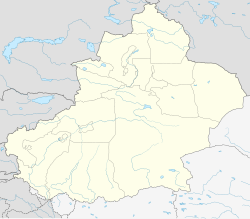Qigexing Buddhist Temple Ruins

View of the ruins
|
|
| Location | Xinjiang, China |
|---|---|
| Coordinates | 41°59′33.62″N 86°13′15.77″E / 41.9926722°N 86.2210472°ECoordinates: 41°59′33.62″N 86°13′15.77″E / 41.9926722°N 86.2210472°E |
| Site notes | |
| Condition | In ruins |
The Qigexing Buddhist Temple Ruins (Uyghur: Хорчу; Xorqu, Chinese: ; pinyin: ; literally: "Seven-Stars Buddhist Temple Ruins") is a ruined compound of Buddhist religious sites located about 25–30 km southwest of the town of Yanqi, Yanqi Hui Autonomous County, Xinjiang, China. The site is believed to have been a major religious center along the northern route of the Silk Road in the second half of the first millennium CE.
The site's Chinese name "Qigexing" has also been spelled as "Shikchin", "Shikshin", "Šikšin", "Xikeqin", or "Xigexing". The archaeologist Albert Grünwedel who worked at the site during the third German Turfan expedition (1905-1907) referred to the site as "Šorčuq"(derived from the Uyghur name Xorqu), this name is also sometimes spelled as Shorchuk, "Chorchuk", or "Shorchuq" and may refer to salt deposits in the surrounding steppes. The site is also referred to as "Ming oi" or "Mingoi", a term that literally means "Thousand Dwellings" in the Uyghur language and is also used for other temple sites in the region such as the Kizil Caves.
Qigexing was part of the ancient Buddhist Kingdom of Karasahr (also spelled "Karashara") that is first mentioned in Chinese sources from the Han Dynasty as the Kingdom of Yanqi (Chinese: 焉耆; pinyin: Yanqi, the Chinese name for Karasahr). In 94 CE, Qigexing was conquered by the Han Dynasty in its reconquest of the Tarim Basin. The Buddhist monk Faxian visited the area of Yanqi around 400 CE and mentions the presence of about 4,000 monks who were practicing Hinayana Buddhism.
...
Wikipedia

